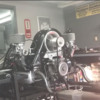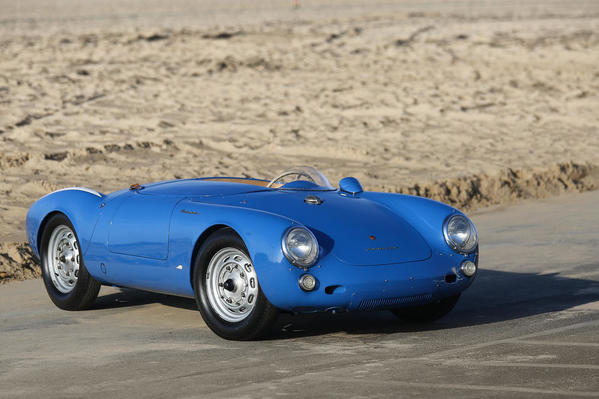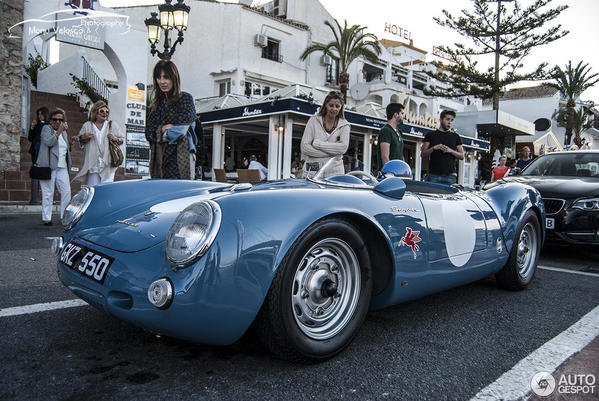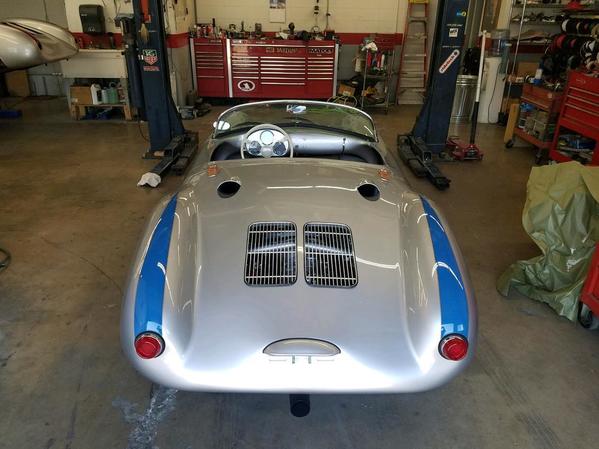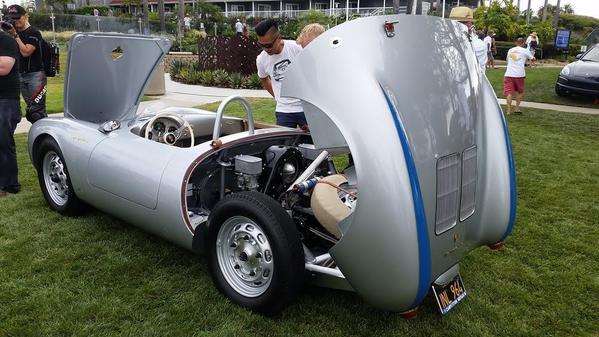I’ll let Anand post the specs and provide more info. I’m just dropping off this little clip of engine ****.
Replies sorted oldest to newest
Swooooon.....
Very nice.
I’ve been sitting on my hands for a couple of months as Anand has been sending information and pictures on this engine/car. Now the cat is out of the bag, I want to gush.
That’s a Pat Downs 2332 Type 1 with a 547 shroud, crankfire ignition, etc. It made over 180 HP at the crank (with 40mm Panchitos!). If that thing doesn’t make you go weak in the knees— you’re on the wrong forum.
Where do you go from here?
Wow. That is a thing of beauty.
Goose bumps and little hairs on the back of my neck stand up; just like I get at the national anthem being sung at the Black Hawks game in Chicago!
Sounds fantastic, and looks incredible too. That kind of power out of 40x35 heads is amazing, and I'll bet throttle response at lower rpm's will be snap your head quick! Anybody care to chime in on specs- cam, compression? Where is redline?
Nice Engine... I might get me back in to A/C....Not....
I am a Kane Fan as well Marty, he is an artist with that puck ![]()
Panhandle Bob posted:Where do you go from here?
Bob,
No wheres, that's heaven.
Glad you all like the motor!
@ALB: It made 181 hp; we ran it up to 5300 rpm (initially we had concerns about the Carrera fan coming apart, as the original 4 cam motors had a 4.5" crank pulley -- ours is larger to cool a bit better!). John Willhoit used such a shroud on a 1900 cc 356 motor, and he had trouble cooling with a 4.5" crank pulley; oil temp was ok, but cylinder head temp was an issue. With a 5" pulley, he had no problems.
The shroud is by Ibrahim Kuzu; it is an exact copy of a Carrera 4 cam shroud, all the way down to the generator stand and dual carrera fan. There is a proper, rebuilt small diameter 12v generator from BNR in there. Fan belt is a Gates XL 10 x 942. (BTW: our fan held up just fine!)
Carbs: 45 Dellorto DRLAs with 38 venturis, .152 Main jets. .70 Idle jets.
Ignition: CB Crank trigger with Dub shop VR sensor and hidden trigger wheel. Crank pulley is a stock 5.7" 356 pulley
Manifolds and heads: 3157 Big Beef manifolds, match ported to Panchitos heads (the very first pair of the new castings done just a few years ago)
Pistons and cylinders: Mahle big bore pistons and cylinders 94 mm
Eagle 2292 camshaft (FK-10)
Aluminum super duty pushrod tubes
That's really all the info I have! I'll post the dyno sheet in a bit.
@chines1 is working on the car -- it is an originally proportioned replica that we are painting in the Porsche French blue color. We have the original Glasurit paint code. Most of these cars were delivered in Sonauto in Paris. Seinfeld sold his (0060) for $5.3m at Gooding not too long ago.
The car will have all of the original touches; after this car, I'm sure Carey will be happy to get rid of me. After 3 cars, I'm sure I'll have pushed him to the limit ![]() . Rest assured that you'll see photos here as things come together...
. Rest assured that you'll see photos here as things come together...
Anand
Dyno sheet attached, for those interested (namely @Stan Galat and @ALB !)
Attachments
That is really excellent! I'd love to have the power that thing has! Wow!
That beauty is something to be really proud of.
(1) Build time?
(2) Will you also have a custom made exhaust installed?
Attachments
So in three seconds, you're getting 192 ft/lbs of torque at a measly 4,500 RPM?
And it's carbureted?
Holy Mother of God...........
Oh, and here's Jerry Seinfeld and his blue 550:

Outstanding! Anxious to see the whole thing when it comes together.
@Cliff Presley - Charlotte, NC -- We have new headers and are using a Sebring type exhaust which fits the car. Below are some photos of the exhaust on the car (it is fitted with a proper belly pan like the real spyders have). Note that the car was previously silver, and is now undergoing a color change...
As for when the car will be done, I'll have to leave that one to @chines1!
Attachments
Dude.
What Stan said. ![]()
Gordon Nichols posted:So in three seconds, you're getting 192 ft/lbs of torque at a measly 4,500 RPM?
And it's carbureted?
Holy Mother of God...........
Gordon, I never realized how amazing Dells were until I met Pat. My buddy Tony collects them and has about 5 sets of every size! He put this set together for me.
The crank trigger system is pretty cool. We've used Dellorto throttle plate screws to hold the trigger wheel on to the pulley with a hidden VR sensor. It retains that old school look, which I love, just like Stan's motor.
Attachments
Attachments
Anand... oui oui oui ![]()
Anand, did you end up using the pulley you purchased from me?
Marty;
Looks like, Porsche #5707 Aquamarinblau . For an accurate answer you could try:
Willhoit Restorations in Long Beach, CA.
Art
I bow my head with great respect.
Thanks @550 Phil, @Marty Grzynkowicz, @Will Hesch, @Stan Galat and @edsnova! Glad you liked it.
Marty-I agree with Art on the color. It is Aquamarine, a 1957 color. Not to be confused with Aquamarine Metallic, which is a 1956 color. BTW, it is Willhoit's birthday today!
Will, yep! That's the pulley we got from you! Where did you get it from, anyway? Forgot to ask you.
Sometimes it's best not to ask........ ![]()
Wow...if the engine looks like art, I can only imagine what the rest of the car will look like. Can’t wait to see it and hear more about it.
Those #'s are fantastic, Anand! It'll have power from the ground up and go like a bat out of hell. Funny how, though, Pat would select a camshaft with the capability to rev to 7,000 rpm or more, and then put heads on it that top out almost 2,000 rpm less. A matched combo usually means all parts selected having the same powerband range for the displacement. I've heard of other engine builders doing it before, but never understood why.
Anand, I purchased it off the Samba and had my machinist/son turn the shaft down for a sand-seal which I wanted for the ill-fated first replacement engine for Whitecloud.
I was then convinced by members of this forum to not use it since it's smaller diameter would offer less cooling ability than a stock diameter pulley.
I then found an ISP faux 356 four-hole aluminum pulley in the stock VW diameter which is what I have on Whitecloud's 3rd engine, the beauty Pat built.
mine
yours I'm glad you could use the original, you've got a bitchin motor, that's for sure!
Attachments
@ALB : We'll have to ask Pat about the choice of cams -- there must be some method to his madness, though I confess that I have no idea what that could be.
@Will Hesch : This pulley was perfect for me -- there's fellow who used a 7" pulley with a Carrera fan on a turbo charged 2 liter, and it ended with a blow up fan! So your fan was the perfect choice! Thanks again!
and the "real" 4 cam pulleys are tiny, the fan would definitely turn slower but maybe too slow?
FWIW @ALB thinks particular cam grinds rev higher than they actually do—or, at least, than guys who build engines for a living think they do. We had this same discussion a few months ago re my Raby 1914, which (by Jake's dyno) peaks at 5500 and loses only 1 percent by 6k. Al thinks it ought to do 500 rpm more; it must be mis-matched heads; he's adamant.
There ought to be a discussion between him and Carey. Or him and Carey and Jake. But at this point I don't know if I'd pay to see it or avoid it at all costs.
Anand
I'm also partial to the color. Mine is Capri Blue. Not exactly the same but pretty close. Also a pic of the original Spyder I'm plagiarizing.
Attachments
Re: cam grinds
The more I know, the more I realize all that I don’t know. More and more, I’m learning to trust the observed findings of guys who build lots and lots of engines (regarding cam selection). The cams we all use (Engle grinds) I understand are just copies of 1960s era Mopar V-8 camshafts. I’m not sure anybody really knows what they do when installed in every possible engine configuration (displacement, heads, intake, exhaust, etc.)
When Anand told me Pat had put it in an FK10 in a 2332 with Panchitos heads it seemed curious.
Looking at the dyno sheet it’s clear that Pat knew what he was doing.
I agree with you, @Stan Galat, the more I know, the more it seems I don't know!![]()
The reason I keep questioning this, @edsnova, is conventional wisdom in the (not just aircooled VW) engine building world has always said that a camshaft's duration (or length of time the valves stay open) dictates an engine's powerband. You match all the parts (cam and rockers, heads, intake, exhaust and compression to make the best power in the same 3,000 or so rpm range, all hopefully reaching their full capabilities at more or less the same time (redline). You normally wouldn't use just a cam, or heads, or exhaust that will make power to 7500 or 8,000 rpm in an engine where the rest of the components will be done some 2 or 3 thousand rpm sooner.
If we look at the dur. @ .050" #'s of Engle's aircooled VW camshafts, you would expect a W100 (236' @ .050") to make power to approximately 5,000 rpm and have a ton of torque from almost idle all the way up. How well it does this depends on how close all the other components come to your intended goal- for example, it would be counterproductive (in this instance) to put 48mm carbs, big valve heads, or even a 1 5/8" exhaust on anything under 2 liters, as any 1 will soften the bottom end, it probably won't have the street manners you're looking for and mileage may suffer as well The engine just will not be all it could be. The same with a 2 liter or larger- 34 Ict's, stock valve heads or a 1 3/8" exhaust will not allow the engine to reach even close to the intended 5,000 rpm redline.
The same goes with the rest of the Engle W line- the W110 (247' @ .050") will make power to 5500 or so rpm, the 120 (253') will allow the engine to rev to 6,000 rpm or so, the W125 (262') to 65000, the W130 (267'- almost the same as the FK10) to about 7,000 and the W140 (274') will go to 7500 (or more). Now this assumes you've matched the other components to the rpm range/redline you're looking for, as well as taking into account displacement (remember, a 2 liter is almost 1/3 bigger than a 1600, so what works for carbs, heads and exhaust on the smaller engine will have to be sized up appropriately for something bigger, at whatever rpm range/redline you're looking for).
Now I know, Ed, you've wondered where I get these rpm ranges and redlines from- a lot of it is from different cam grinders recommendations, a little my own experience (I have run a Scat C25, W110 and W125 and Bugpack 4063? in engines I've built and I can tell you that the W125 will go to 6500 with power if everything is right, Ed) and a bunch more of it observations from other people (you guys see now why I'm always asking about specs with every build someone does here? You can never know too much; a smart man is always learning, and I like to think of myself as in that camp. It's all data, baby!). Anyway....
When someone with waaaaaaaayyyyyyyyy more experience than I does something that goes against the accepted conventional wisdom, I do take notice. Pat did the same thing (overcammed an engine by a good step or 2) previously in the Hot VW's "Engine Builders' Challenge" (iIrc that's what it was called) 5? 6? years ago (I'll look it up later), made 10 or 12 hp (with a big fat torque line, if I recall) than anybody else. I did go "hmmm...." and then promptly forgot about it, as I am easily distracted and have a very poor short term memory (my lovely wife will attest to- oh yeah, I just remembered I bought cookies yesterday! double chocolate... and you guys think I'm kidding!).
Anyway- after subsequently reading about a couple other guys doing the same thing and now Anand's engine with such great power output, I think I know what's going on. I think this is a way of getting the most from a set of heads- the big duration and lift letting the engine make as much power as possible while still not turning that much rpm's. 180 hp is huge (thought to be pretty well the absolute limit) for a 40x35 head. With that much duration, though, it would be interesting to see how it behaves/drives in the lower rpm's and off idle (although with a car as light as a Spyder and that much displacement, it probably doesn't matter!). Al
And btw, the cookie was delicious! (chocolate chocolate chip- my favorite!)
I have found that using longer duration cams with cylinder heads that have high port velocity give the best of both power and driveability. The Panchito head has extremely high intake port velocity, borderline too high, close to 340 fps. Because of this high port velocity, I can go up 5-10 degrees more on duration yet still keep low end driveability. Bigger engines can use more duration, smaller ones less using this theory.
Anands engine has 10-1 compression, pushing the envelope of unleaded fuel here in California.The added cam overlap of the FK-10 helps reduce cylinder pressure, this helps to prevent detonation. I ground his cam on a 107 degree lobe center line. This also help lower the rpm that peak HP and torque come in at. You can see this in the dyno graph.
I have the luxury of trying allot of different things with engines, some work and some don't. Anands engine is one of my tried and true combinations. I build many of these same engines with excellent feedback from customers.
Not very long ago I was referred to "an old dog who can't learn new tricks" Those who know me know this is far from true. I have helped CB Performance stay at the top of the industry with design and development in the VW industry. I constantly learn and apply what I know to these engines. This year, I traveled back east to North Carolina and smashed the ECPRA Pro Stock record with my 174 CI VW engine. I developed this engine over the last 4 years, it has technology in it that no one has thought of or tried before.
I'm not one to brag, I actually try to talk as little as possible LOL. But, to the person who called me the old dog who can't learn, I hope you read this some day and know that my right middle finger is projected and waiving at you!




